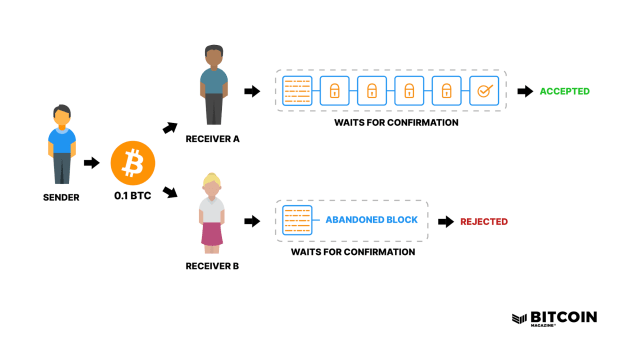Blogs & Articles: What Is The Byzantine Generals Problem? 🔗 31 weeks ago

- Category: Blogs & Articles | Bitcoin Magazine: Bitcoin News, Articles, Charts, and Guides
- Author(s): Bitcoin Magazine
- Published: 27th September 2023 14:25
Introduction
The Byzantine Generals Problem is a game theory problem that reveals the challenges of achieving consensus among a group of mutually suspicious entities using unreliable communication channels. Game theory refers to the best strategy adopted by independent and competing actors in decision-making.
This article explores the concept of the Byzantine Generals Problem, its foundation, how it applies to networked systems and money, and how Bitcoin’s combination of its different elements enables the best-suited consensus to resolve the issue.
The Byzantine Generals Problem is particularly experienced in distributed computing, where it’s more difficult for decentralized parties to reach a consensus without relying on a trusted central party.
The game theory analogy is framed around a group of generals besieging Byzantium, with each general in charge of a division of the army. They must be coordinated to either attack the city or retreat; if the coordination succeeds, all generals attack simultaneously, and they will win, but if they are not coordinated, they will lose.

How can the generals coordinate to attack simultaneously if they have to rely on messengers who can be intercepted or corrupted by Byzantium’s defenders?
They must design a protocol that allows the loyal generals to reach a robust consensus to combat the dishonest Byzantine generals.
Centralized And Decentralized Systems
The Byzantine Generals Problem doesn’t occur in centralized systems, because the decisions are always taken by the central authorities involved in the organization's decision-making process.
Therefore, the challenge lies in ensuring the reliability and integrity of the communication between the authority and the subordinate entities rather than achieving consensus among multiple independent parties, as in the case of distributed systems. In such systems, the messages or commands the authority sends mustn’t be tampered with or maliciously altered during transmission.
The Byzantine Generals Problem is only common to decentralized systems, where reaching an agreement is more challenging. The network must be designed with secure communication channels so that no messaging service is intercepted or interrupted to prevent the success of an attack.
Historical Background
The Byzantine Empire's Influence
While the term "Byzantine Generals Problem" isn’t directly connected to the historical Byzantine Empire, some parallels and potential influences may have led to the concept's origin.
The Byzantine Fault Tolerance, referred to in distributed computing, implies the ability of a system to tolerate faulty or malicious components. In this context, the term "Byzantine" is inspired by the Byzantine Empire's historical challenges of coordinating actions and communication among its generals, some of whom could be traitorous or unreliable.
Furthermore, the Byzantine Empire had a highly hierarchical structure with decentralized decision-making, where various generals and commanders were responsible for leading their respective armies. Similarly, nodes or entities in distributed systems may have independent decision-making capabilities, and achieving consensus among them poses challenges comparable to coordinating actions among multiple Byzantine generals.
The parallel with the Byzantine Empire in the Byzantine Generals Problem provides a symbolic framework for understanding the difficulties encountered in achieving consensus and fault tolerance in distributed systems. The complex decision-making dynamics and potential for malicious behavior seen in historical Byzantine military campaigns represent the challenges which distributed computing faces.
Origin Of The Byzantine Generals Problem
The term Byzantine Generals Problem was first introduced by computer scientists Leslie Lamport, Robert Shostak, and Marshall Pease in a paper published in 1982.
The National Aeronautics and Space Administration, the Ballistic Missile Defense Systems Command, and the Army Research Office partly supported the research paper. Such funding emphasizes the importance of this issue and that the concept can be applied to military communication, other than all types of computer systems.
In modern computing, the Byzantine Generals Problem must be solved if a dispersed group of nodes (e.g., computers or other physical devices) needs to achieve reliable communications.
Analogy To Modern Computing
The Byzantine Generals Problem mainly affects distributed computing because achieving consensus in a network where nodes can be faulty or malicious is challenging. It has applications in various areas, including fault-tolerant systems, distributed databases, and blockchain technology. The problem has urged the development of Byzantine fault-tolerant consensus protocols and algorithms, which are crucial in ensuring the reliability and consistency of distributed systems.
In blockchain systems, the Byzantine Generals Problem is addressed in consensus protocols like proof of work (PoW) to reach an agreement among multiple nodes in a trustless environment. Byzantine fault tolerance represents an essential characteristic of decentralized blockchain networks.
In cybersecurity and intrusion detection, the Byzantine Generals Problem analogy helps understand the challenges of securing computer networks against malicious actors who may attempt to disrupt communication, tamper with data or launch attacks, and helps identify and mitigate such potential threats.
The Byzantine Generals Problem finds application in internet of things (IoT) networks, where numerous devices must communicate and cooperate to perform tasks. Ensuring consensus and coordination among IoT devices, especially in the presence of unreliable or compromised nodes, is crucial for maintaining the integrity and security of IoT systems.
The Byzantine Generals Problem is also essential in cloud computing to ensure reliability and fault tolerance in distributed cloud environments. Byzantine fault-tolerant protocols can handle faults and malicious behaviors within cloud computing systems.
Popular Byzantine Fault-Tolerance Algorithms
To ensure that a tiny group of malicious actors cannot disrupt a distributed system, an algorithm is required to provide the solution. Several algorithms, such as Byzantine fault-tolerant consensus protocols, have been developed to allow reliable distributed computing to deal with Byzantine failures.
Practical Byzantine Fault Tolerance (PBFT):
Practical Byzantine Fault Tolerance (PBFT) is a consensus algorithm in distributed systems that tolerates up to one-third of the total number of Byzantine nodes, meaning they can exhibit arbitrary and potentially malicious behavior without affecting the network.
The algorithm ensures that the system reaches agreement on the order of requests in the shortest time possible and maintains consistency even in Byzantine failures. Using a combination of digital signatures, timeouts, and acknowledgments, PBFT ensures that the consensus process progresses even if some nodes are faulty or malicious and that the system can continue to progress as long as the majority of nodes are honest.
Federated Byzantine Agreement (FBA):
Federated Byzantine Agreement (FBA) is another consensus algorithm in distributed systems designed for a decentralized network of nodes that can reach consensus without relying on a centralized authority.
FBA is based on federating independent nodes into groups (federations). Each federation consists of a set of nodes that mutually trust each other. The algorithm ensures that nodes within a federation agree on the ordering and validity of transactions or events while allowing different federations to have separate consensus processes. Fedimint is the most known federation and open-source protocol to transact and custody bitcoin, and it uses the honey badger Byzantine fault-tolerant (HBBFT) consensus algorithm.
Bitcoin's Solution: Proof-Of-Work:
While Bitcoin’s proof of work (PoW) consensus mechanism is not technically a Byzantine fault-tolerant algorithm, it is nonetheless used to make Bitcoin Byzantine fault tolerant. Network nodes cannot declare a block valid unless it contains a proof-of-work hash, indicating that work was done to produce it.
Byzantine fault tolerance requires tolerating a certain number of faulty or malicious nodes in the network while reaching a consensus. Bitcoin's PoW consensus mechanism offers probabilistic finality, meaning that the longer the blockchain becomes, the more difficult it becomes for an adversary to perform an attack and rewrite or alter the history.
Comparison Of BFT Algorithms:
Several Byzantine fault-tolerant (BFT) algorithms are available, each with its own characteristics, trade-offs, and suitability for different use cases.
The choice of a BFT algorithm depends on factors such as performance, fault tolerance, scalability, transaction finality, network characteristics, and trust assumptions that suit the different blockchains, from permissioned or permissionless networks to distributed databases or file systems.
Byzantine Generals Problem In Computer Networks
There are several reasons why a distributed computer system could have unavoidable Byzantine failures, and they are not always coordinated malicious attacks. From a software defect to a hardware malfunction, nodes may present different difficulties that prevent them from reaching a consensus on distributed networks.
Reasonably secure networks can withstand a few offline or malicious nodes without affecting the whole network, and Byzantine fault tolerance is the ability to handle such conditions. In
2008 Bitcoin’s white paper proposed a solution to computer science’s Byzantine Generals Problem:
“A purely peer-to-peer version of electronic cash would allow online payments to be sent directly from one party to another without going through a financial institution,” stated Satoshi Nakamoto in the paper.
He created a global monetary system that could be trustless for the first time in history, programmed to disincentivize bad behavior and encourage nodes and miners to act honestly instead.
Money And The Byzantine Generals Problem
The Byzantine Generals Problem analogy can be extended to money and financial transactions, particularly in the context of decentralized digital currencies like bitcoin.
How can financial transactions be executed in a secure and trustless environment without the need for a central authority to verify and finalize the transfer of value, even in the presence of Byzantine behavior?
To solve the Byzantine Generals Problem, money must be completely trustless. Therefore; it should be verifiable, secure, transparent, decentralized and counterfeit resistant. Bitcoin was designed with these attributes serving as its fundamental principles resulting in a breakthrough solution to the Byzantine Generals Problem.
Bitcoin’s Solution
- Blockchain Solves The Double-Spend Problem
Bitcoin handles users’ ownership and prevents double spending in a trustless manner using a blockchain, the public and distributed ledger, which stores a history of all transactions and the truth that all parties (the nodes) must approve to resolve the Byzantine Generals Problem.
Double spending refers to the possibility of spending the same digital currency unit more than once, which would undermine the integrity and value of the currency.

Such a network of nodes is necessary to verify bitcoin ownership through consensus mechanisms and cryptographic techniques (such as digital signatures) solving the double-spending problem without a central authority.
Byzantine fault-tolerant consensus protocols in blockchain systems help prevent double spending by establishing agreement on the order and validity of transactions. Trust is placed in the underlying protocol and network consensus rather than a central intermediary.
- Proof-Of-Work Solves The Byzantine Generals Problem
Proof of work requires a lot of energy, labor, and expense to produce a new block. This proof of computational work helps to secure the network against sybil attacks by ensuring that adding new blocks to the chain is resource-intensive and costly.
Network members who publish false information will be immediately detected by all nodes who recognize it as invalid and ignore it. Bitcoin is a trustless system since every node can verify all information on the network without needing to trust other network members.
Conclusion
As society moves increasingly toward distributed systems and adopts decentralized money like bitcoin, the Byzantine Generals Problem approach becomes essential to coordinate the actions of multiple independent parties without relying on central authorities.
To be successful, systems must ensure Byzantine fault tolerance and guarantee resilience and security — even in the presence of flawed information — so that a consensus can be reached despite the possibility of deception and betrayal from some parties.
Bitcoin is ideally suited to provide a trustless environment to handle attacks. Its proof-of-work algorithm has protected the network’s security by fostering competition among miners, making it computationally infeasible for any single entity to control the network. This decentralized nature of Bitcoin, underpinned by Byzantine fault tolerance, showcases a robust model for ensuring consensus and security amidst potential misinformation and malicious intents.










